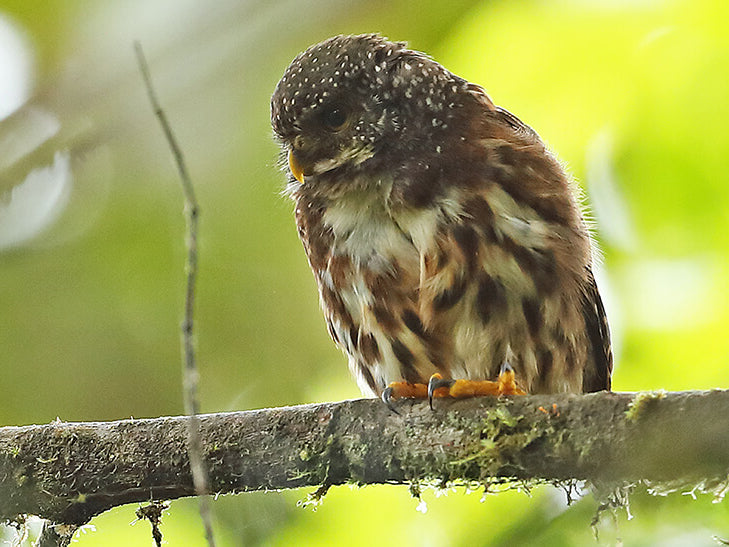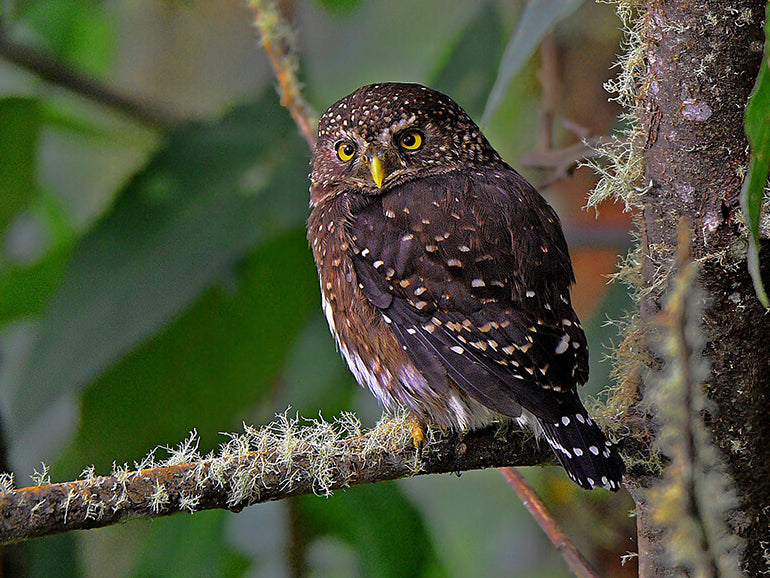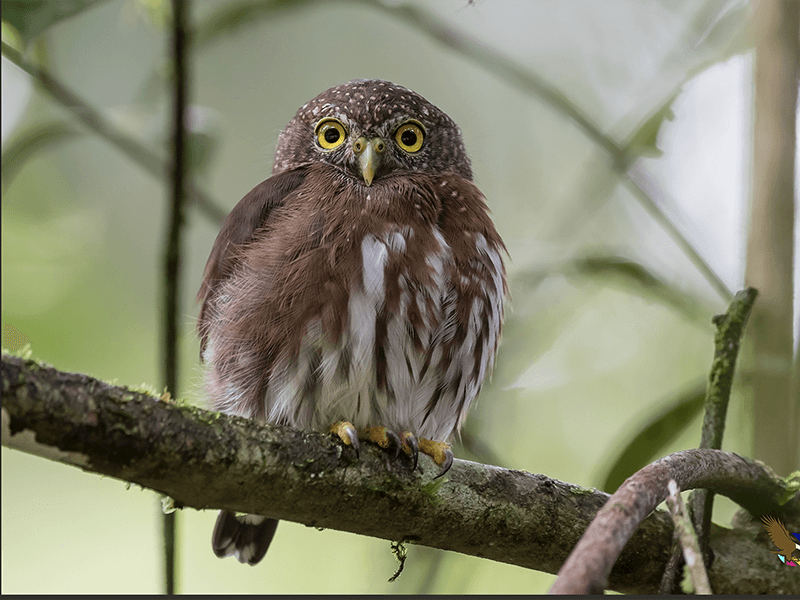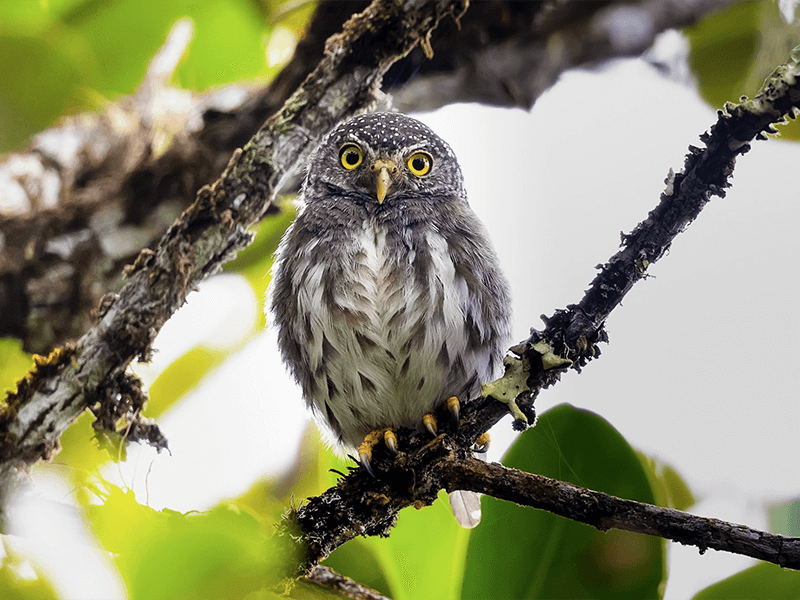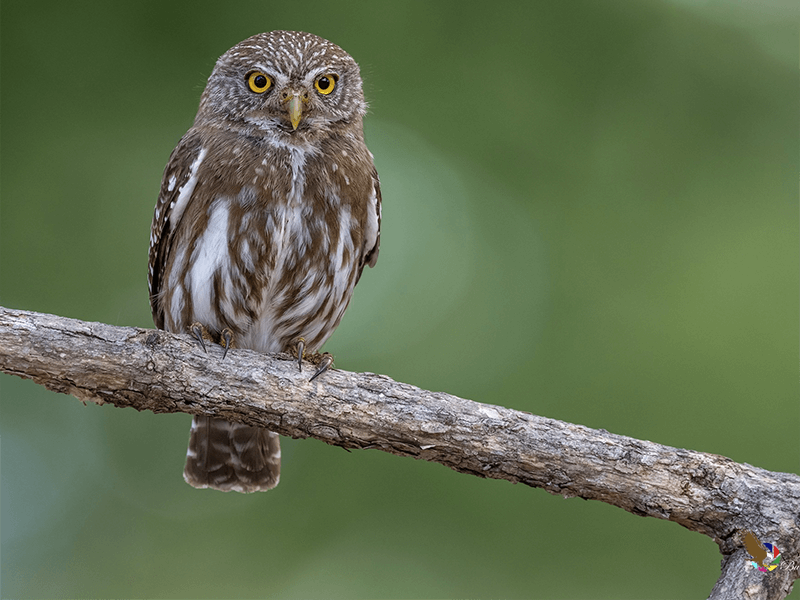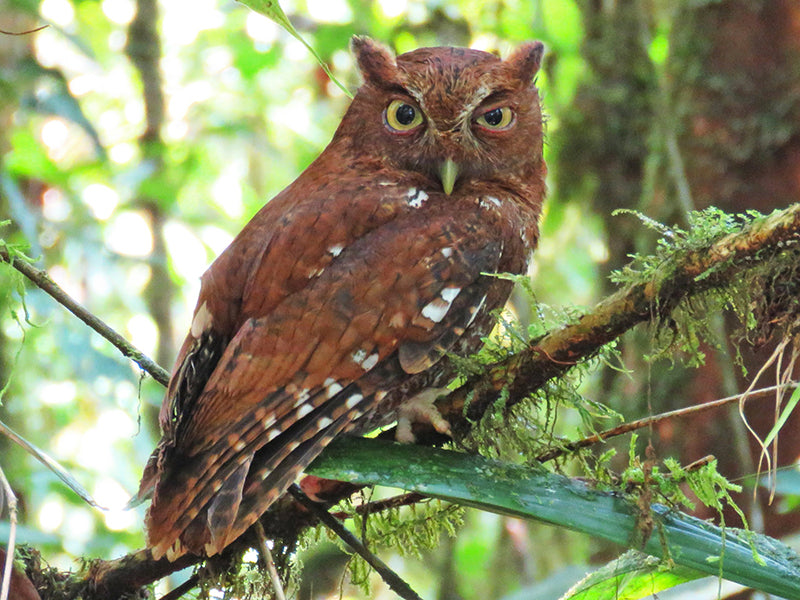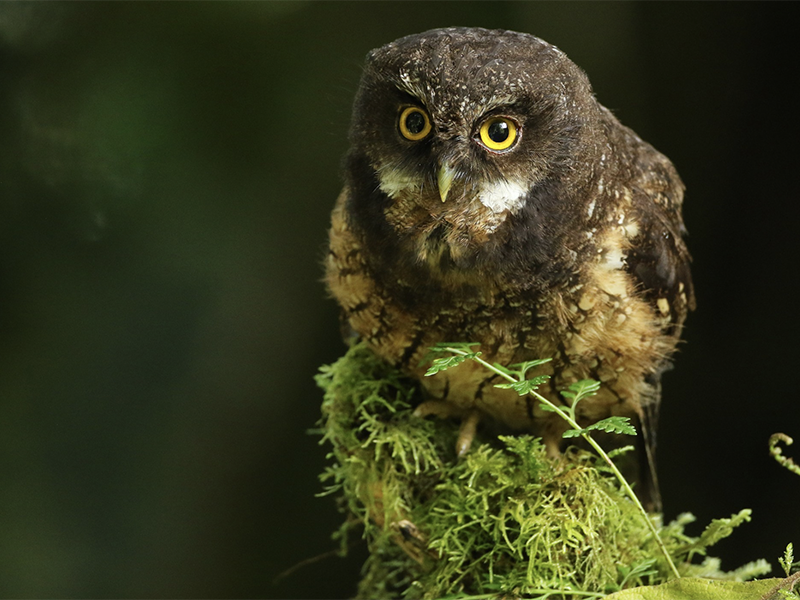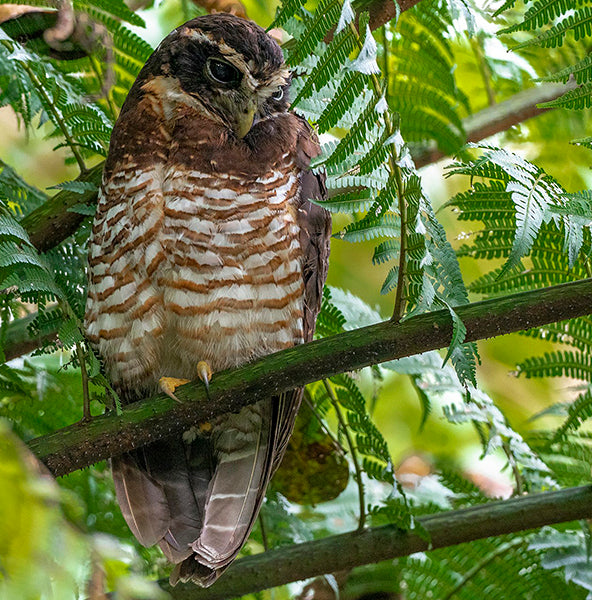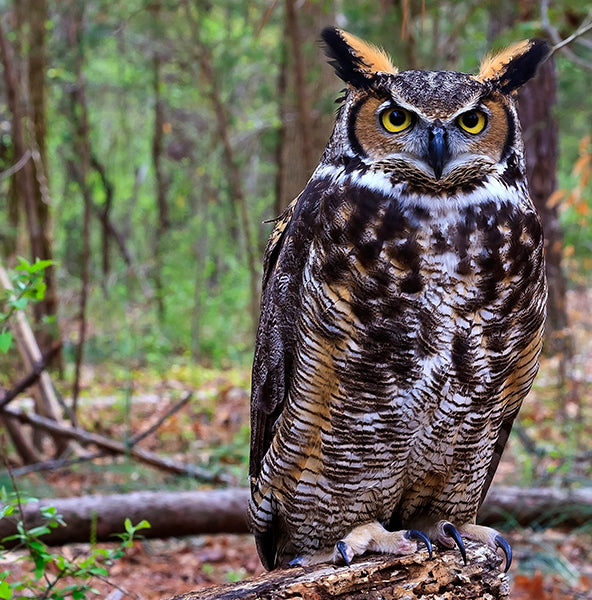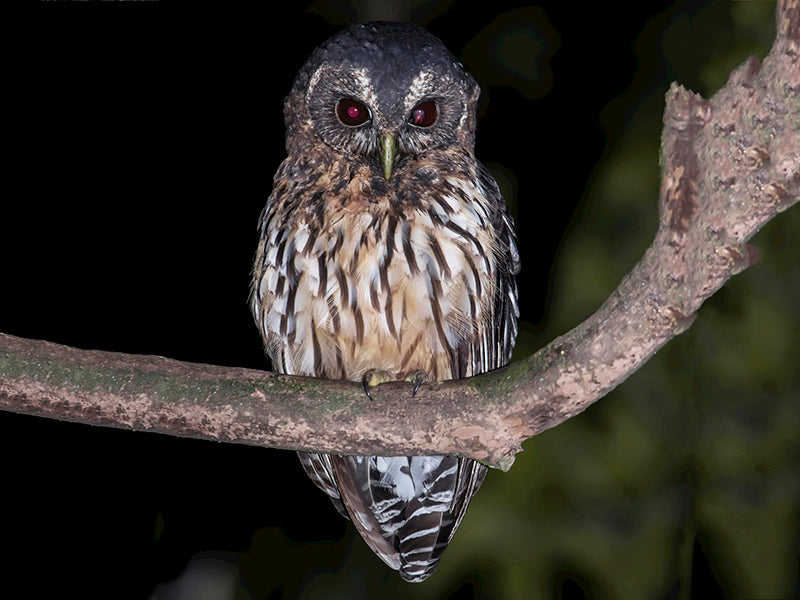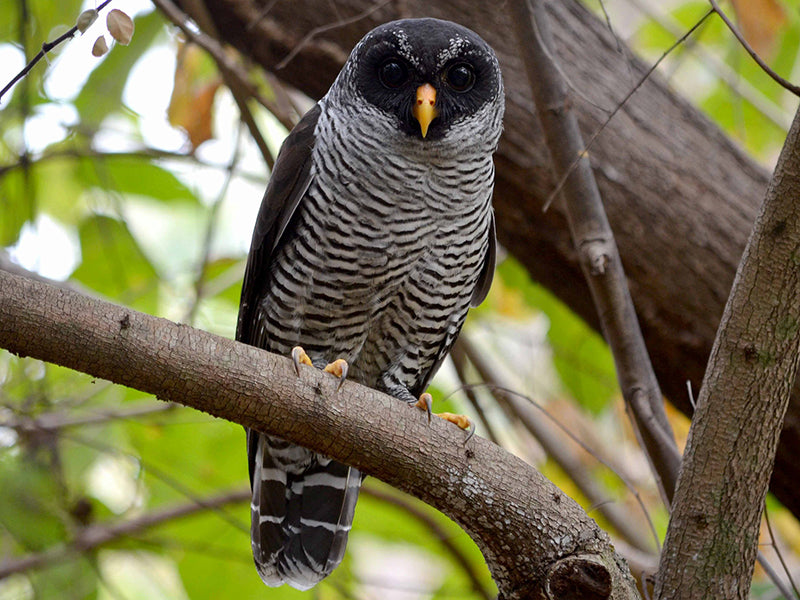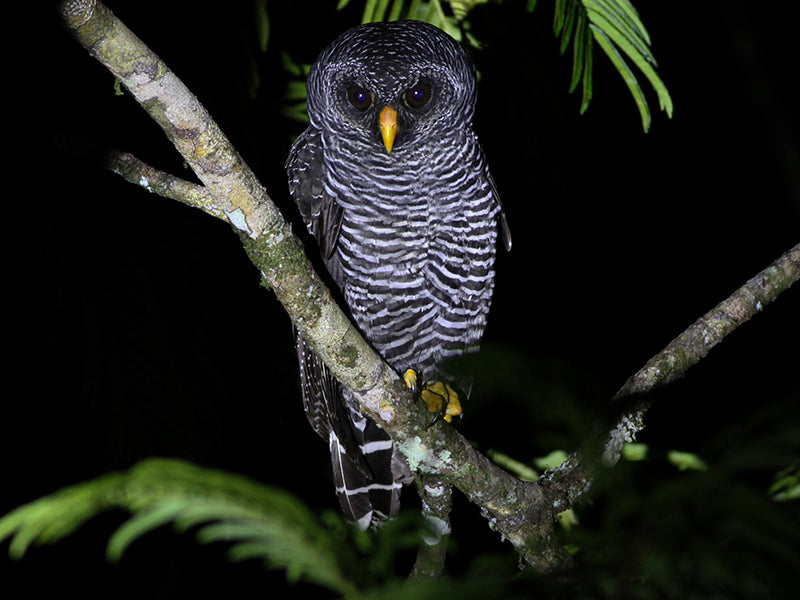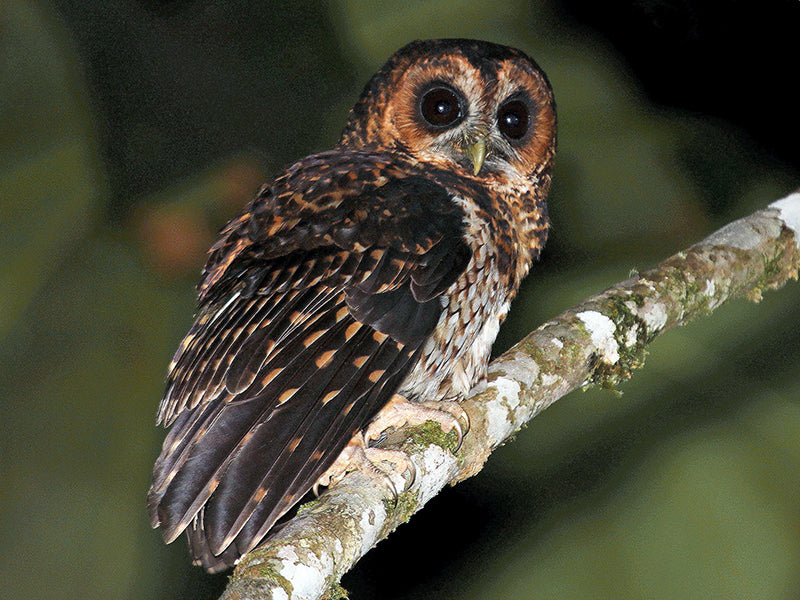Typical Owls
Behavior: Typical owls are primarily nocturnal, meaning they are active during the night and hunt their prey under the cover of darkness. Their adaptations, such as specialized vision and hearing, help them navigate and hunt effectively in low light conditions.
Facial Disc: Many typical owls have a facial disc, a collection of feathers arranged in a circular pattern around their faces. This facial disc helps funnel sound towards their ears, aiding in locating prey by sound.
Ear Tufts: Some typical owl species have prominent feathered ear tufts on the top of their heads. Contrary to popular belief, these ear tufts do not play a role in hearing but are used for camouflage and communication.
Distinctive Calls: Typical owls are known for their range of vocalizations, including hoots, screeches, whistles, and hisses. These calls serve various purposes, such as defending territory, attracting mates, and communicating with their young.
Variety of Sizes: The size of typical owls varies significantly among species. Some are relatively small, like the Elf Owl which is around 5 inches in length, while others are much larger, such as the Eurasian Eagle Owl which can have a wingspan of over 6 feet.
Habitat and Range: Typical owls are found in a wide range of habitats around the world, including forests, grasslands, deserts, and Arctic tundra. They have adapted to various environments and can be found on every continent except Antarctica.
Diverse Diet: Typical owls have a diverse diet that includes small mammals, birds, reptiles, insects, and even fish. They are skilled hunters with sharp talons and beaks that enable them to catch and kill their prey efficiently.
Nesting Habits: Typical owls typically nest in trees, cliffs, or abandoned nests of other birds. They are known for their parenting behaviors, including the care of their young and the defense of their nesting territory. Typical owls are a diverse group of nocturnal birds of prey with unique adaptations for hunting and survival. Their intriguing characteristics, behaviors, and wide distribution make them fascinating subjects for bird enthusiasts and researchers alike.
Cloudforest Pygmy-owl
Glaucidium nubicola
Spanish Name: Buhito Nubícola
Size: 6 in | 15 cm
Habitat: Dense forests, wooded areas, and plantations
Height: 1400-2000 m
Photo: © neil bowman iStock/Getty Images Plus
Andean Pygmy-owl
Glaucidium jardinii
Spanish Name: Buhito Andino
Size: 6 in | 15 cm
Habitat: Dense forests, wooded areas, and plantations.
Height: 2000-3500 m
Photo: © Eduardo Lago V.
Central American Pygmy-owl
Glaucidium griseiceps
Spanish Name: Buhito Cabecigris
Size: 6 in | 14.7 cm
Habitat: Dense tropical forests.
Height: <1500 m
Photo: © Fernando Burgalin Sequeria eBird S59628900 Macaulay Library ML176362741
Ferruginous Pygmy-owl
Glaucidium brasilianum
Spanish Name: Buhito Ferrugíneo
Size: 6.3 in | 16 cm
Habitat: Forests, scrublands, and open woodlands.
Height: <1200 m
Photo: © fernando Burgalin Sequeria eBird S132649544 Macaulay Library ML564560641
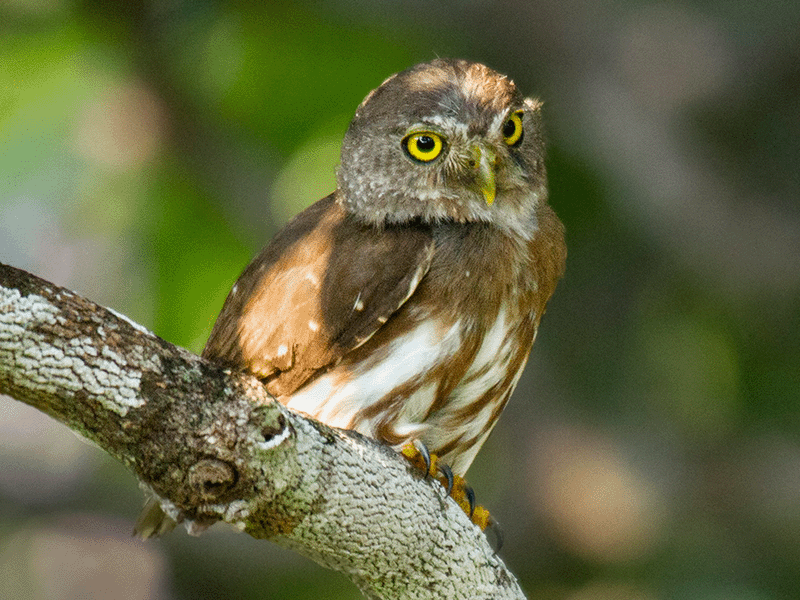
Amazonian Pygmy-owl
Glaucidium hardyi
Spanish Name: Buhito Amazónico
Size: 5.5 in | 14 cm
Habitat: Subtropical or tropical moist montane forests and shrublands of the Andes mountains.
Height: <1000 m
Photo: © Andres Vasquez Noboa eBird S47123735 Macaulay Library ML 244324871

Burrowing Owl
Athene cunicularia
Spanish Name: Mochuelo Conejo
Size: 9 in | 23 cm
Habitat: Well-adapted for a ground-dwelling lifestyle and are often found in open areas.
Height: <1000 m
Photo: © Rafael Cerqueira iStock/Getty Images Plus
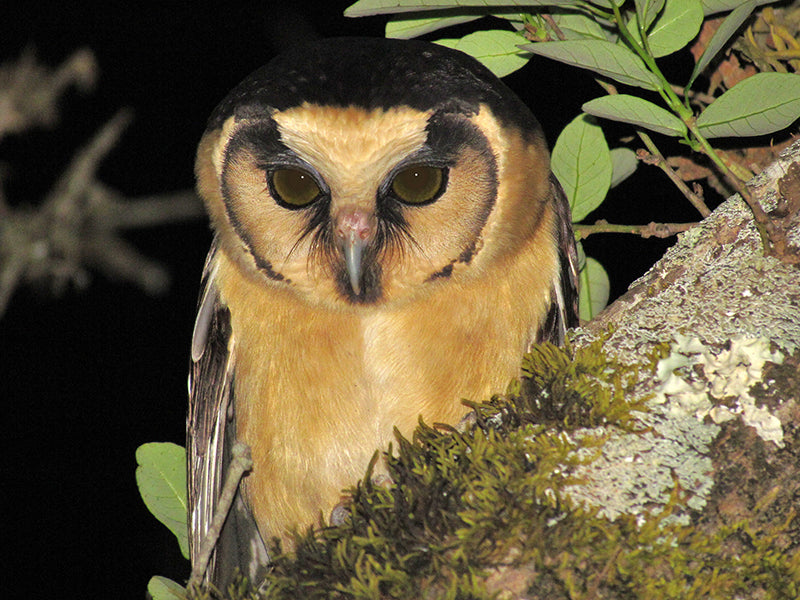
Buff-fronted Owl
Aegolius harrisii
Spanish Name: Búho Acanelado
Size: 9 in | 23 cm
Habitat: Dense, humid montane forests with a mix of trees, shrubs, and undergrowth.
Height: 1300-3400 m
Photo: © Fabio Maffei iStock/Getty Images Plus
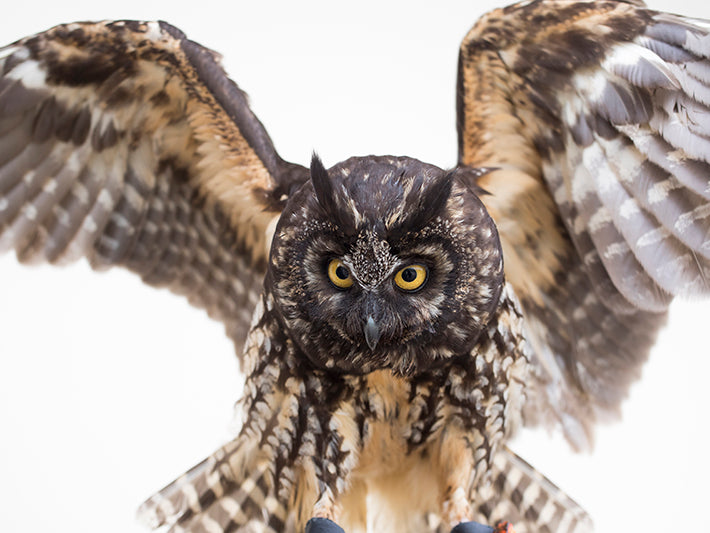
Stygian Owl
Asia stygius
Spanish Name: Búho Orejudo
Size: 17 in | 43 cm
Habitat: Dense forests, including rainforests, cloud forests, and montane forests.
Height: 400-3000 m
Photo: © Luis Astudillo iStock/Getty Images Plus
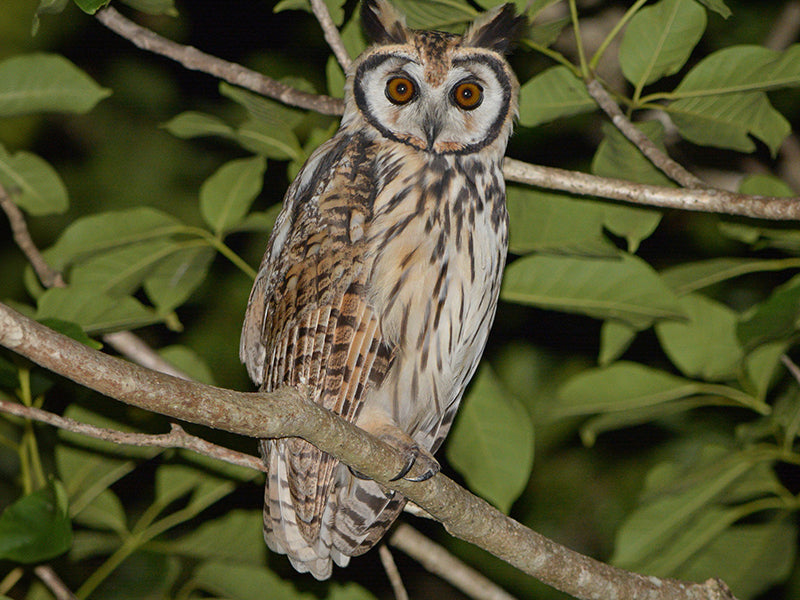
Striped Owl
Asia clamator
Spanish Name: Búho Rayado
Size: 15 in | 38 cm
Habitat: From humid forests to open grasslands and agricultural areas.
Height: <2600 m
Photo: © Jorge Dangel eBird S47181358 Macaulay Library ML 107508511
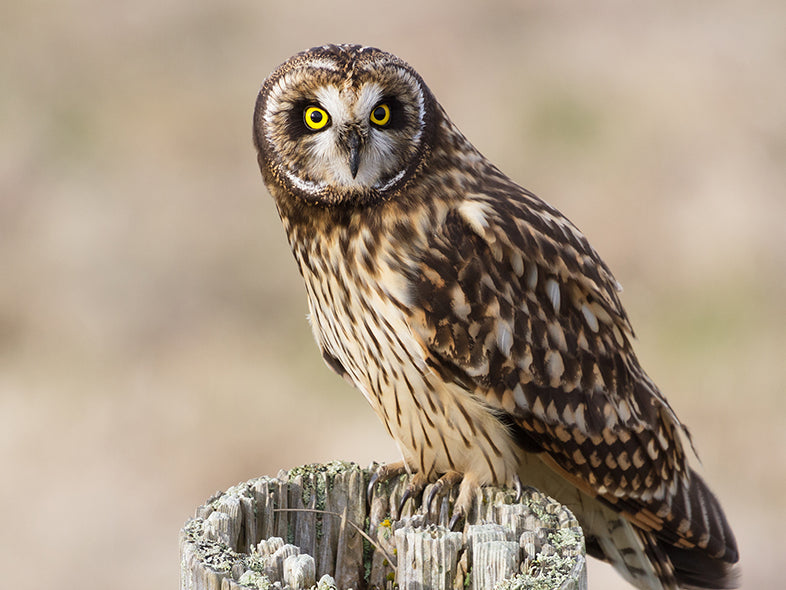
Short-eared Owl
Asia flammeus
Spanish Name: Búho Campestre
Size: 15 in | 38 cm
Habitat: Open habitats, such as grasslands, marshes, meadows, and tundra regions.
Height: 300-3500 m
Photo: © Devonyu iStock/Getty Images Plus
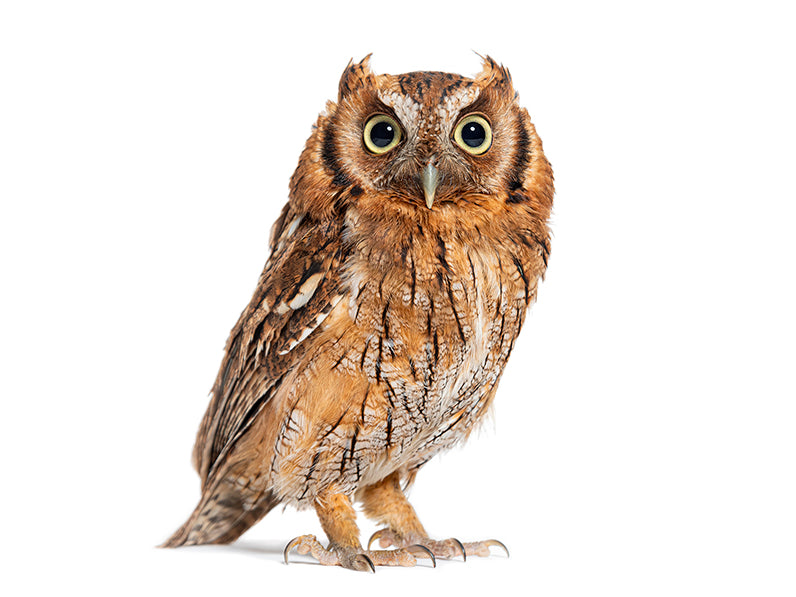
Tropical Screech-owl
Megascops choliba
Spanish Name: Currucutú
Size: 8.5 in | 22 cm
Habitat: Tropical rainforests, humid forests, and wooded areas.
Height: <2800 m
Photo: © GlobalP iStock/Getty Images Plus
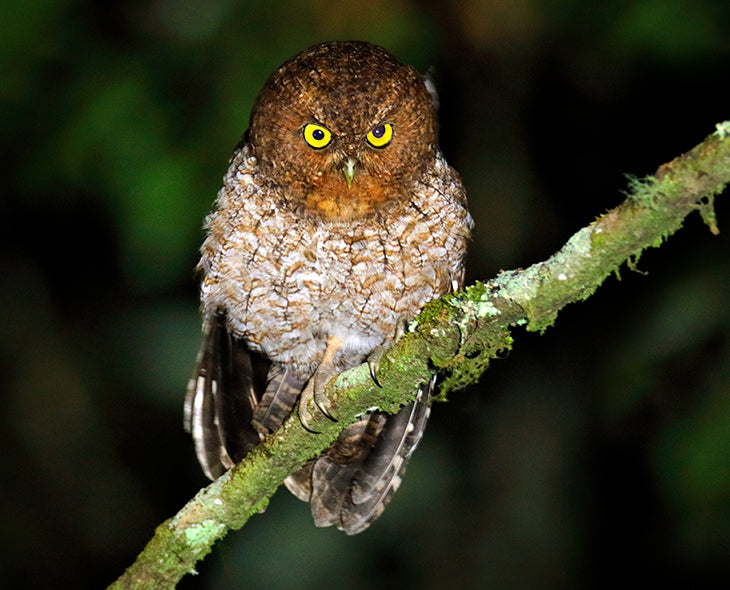
Bare-shanked Screech-owl
Megascops clarki
Spanish Name: Autillo Manchado
Size: 9.5 in | 24 cm
Habitat: Dense forests with a mix of tall trees and undergrowth
Height: 1400-1500 m
Photo: © Ondrej Prosicky iStock/Getty Images Plus

Rufescent Screech-owl
Megascops ingens
Spanish Name: Autillo Grande
Size: 10 in | 25 cm
Habitat: Dense forests in mountainous regions, often found in areas with thick vegetation and a diverse array of trees and plant species.
Height: 1100-2200 m
Photo: © Nick Athanas eBird S49562052 Macaulay Library ML 121273801
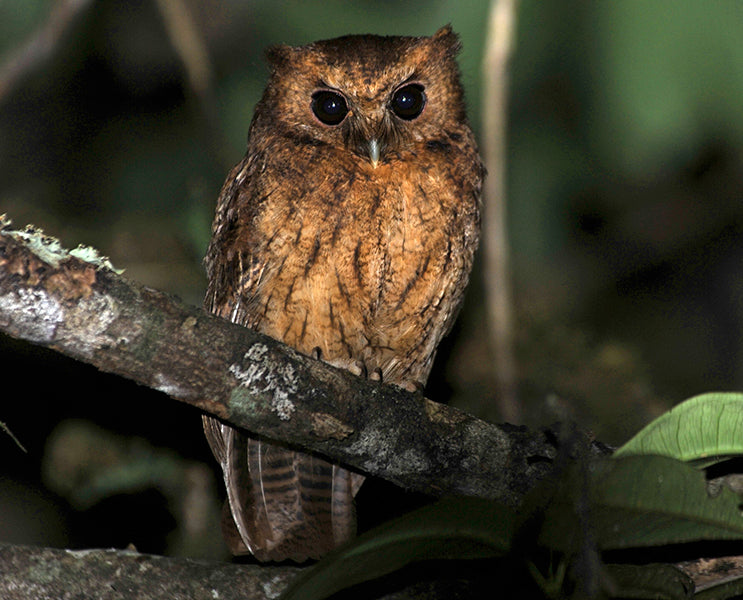
Cinnamon Screech-owl
Megascops petersoni
Spanish Name: Autillo canela
Size: 9 in | 23 cm
Habitat: Dense forests, including cloud forests, where they roost during the day and hunt at night.
Height: 1500-2300 m
Photo: © Alan Van Norman eBird S6880068 Macaulay Library ML 39664261
Choco Screech-owl
Megascops centralis
Spanish Name: Autillo del Chocó
Size: 8.2 in | 21 cm
Habitat: Dense, wet forests with abundant vegetation, where they roost during the day and hunt at night. They are well-adapted to the environmental conditions of the humid forests in the Chocó region.
Height: <1600 m
Photo: © Tim Forrester eBird S35776120 Macaulay Library ML 54107841
Foothill Screech-owl
Megascops roraimae
Spanish Name: Autillo de Colina
Size: 8.5 in | 22 cm
Habitat: Dense woodland areas, including humid montane forests and cloud forests.
Height: 600-1500 m
Photo: © Nick Athanas eBird S49527985 Macaulay Library ML 121275421
Santa Marta Screech-owl
Megascops gilesi
Spanish Name: Autillo de Santa Marta
Size: 8.5 in | 22 cm
Habitat: Humid montane forests and cloud forests in the Sierra Nevada de Santa Marta.
Height: 1800-2500 m
Photo: © Ondrej Prosicky iStock/Getty Images Plus
White-throated Screech-owl
Megascops albogularis
Spanish Name: Autillo Gorgiblanco
Size: 10 in | 25 cm
Habitat: Forested areas, including tropical and subtropical forests, montane forests, cloud forests, and woodland habitats.
Height: 2000-3500 m
Photo: © Luke Seitz eBird S47221604 Macaulay Library ML108713911
Spectacled Owl
Pulsatrix Perspicillata
Spanish Name: Búho de Anteojos
Size: 18 in | 46 cm
Habitat: Dense, humid forests, including lowland rainforests, cloud forests, and montane forests.
Height: <1400 m
Photo: © Eduardo Lago V.
Band-bellied Owl
Pulsatrix melanota
Spanish Name: Búho Barrado
Size: 15 in | 38 cm
Habitat: Dense forested habitats, often favoring areas near streams or water sources.
Height: 500-1800 m
Photo: © Andres Vasquez Noboa eBird S83873074 Macaulay Library ML 318913621
Crested Owl
Lophostrix cristata
Spanish Name: Búho Crestado
Size: 16 in | 41 cm
Habitat: Humid forests, including primary and secondary forests, as well as forest edges and disturbed areas near water sources.
Height: <2000 m
Photo: © Daniel Jara iStock/Getty Images Plus
Mottled Owl
Ciccaba virgata
Spanish Name: Búho Moteado
Size: 14 in | 36 cm
Habitat: Humid forests, both primary and secondary, but they can also inhabit wooded areas, plantations, and forest edges.
Height: <2200 m
Photo: © Guillermo Saborío Vega eBird S30913098 Macaulay Library ML 32516251
Black-and-white Owl
Ciccaba nigrolineata
Spanish Name: Búho Carinegro
Size: 17 in | 43 cm
Habitat: Humid forests, both primary and secondary, with dense foliage that provides ample cover for roosting and hunting.
Height: <2000 m
Photo: © Leonardo Ordóñez-Delgado eBird S64967448 Macaulay Library ML 204103941
Black-banded Owl
Ciccaba huhula
Spanish Name: Búho Negro
Size: 15 in | 38 cm
Habitat: Humid tropical forests, especially those near rivers or streams. They may also occur in forest edges and fragmented habitats, but their primary preference is undisturbed forest with dense vegetation where they can remain concealed during the day.
Height: <900 m
Photo: © Jan Harm Wiers eBird S32804606 Macaulay Library ML 42207561
Rufous-banded Owl
Ciccaba albitarsis
Spanish Name: Búho Ocelado
Size: 15 in | 38 cm
Habitat: Moist, montane forests with tall trees, dense undergrowth, and epiphytes. They may also occur in disturbed or secondary forests but are primarily associated with undisturbed forest habitats.
Height: 1800-3000 m
Photo: © Matthew Grube eBird S38679606 Macaulay Library ML 67999601

